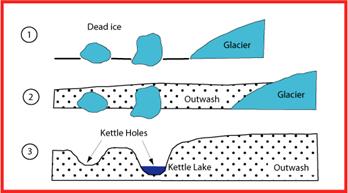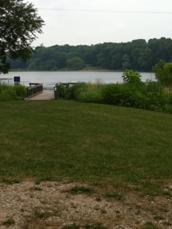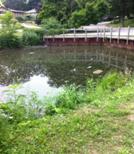|
Connection to the Earth Science Curriculum
Essential
Lesson:
At
Woods Lake visitors will gain an understanding that humans have
lasting effects on their environment.
Earth Science Literacy Principles-
Big Idea 3: Earth is a complex system of
interacting rock, water, air, and life.
Big Idea 5: Earth is a water planet.
Common misconceptions
Nutrients float around in the water column and
cause water to be cloudy.
High levels of nutrients are toxic to fish and
invertebrates
Michigan
State Science Content Expectations Addressed:
Grade Six- E.SE.06.12 Explain how waves, wind,
water, and glacier movement, shape and reshape the land surface of
the Earth by eroding rock in some areas and depositing sediments in
other area.
Grade Seven-E.ES.07.41 Explain how human
activities (surface mining, deforestation, overpopulation,
construction and urban development, farming, dams, land?lls, and
restoring natural areas) change the surface of the Earth and affect
the survival of organisms.
Grade Seven-E.ES.07.42 Describe the origins of
pollution in the atmosphere, geosphere, and hydrosphere, (car
exhaust, industrial emissions, acid rain, and natural sources), and
how pollution impacts habitats, climatic change, threatens or
endangers species
Access:
The park is owned by the city of Kalamazoo and
much of the surrounding lake property is owned by an
association. Please respect all posted
signs.
Date Visited: July 18, 2011
|
Woods Lake EarthCache
Woods Lake is a 26 acre kettle lake with public access through the
Kalamazoo Park system that provides an excellent example of
cultural eutrophication in an inland
lake. EarthCache visitors will be able to observe this inland water
feature created by glaciers of the past.
Coordinates:
N 42o15.652’, W 85 o37.150’
Materials needed for your visit:
The information provided, GPS, Journal
Directions:
1. Before
you leave make sure that you know how to use your GPS
Enter and label waypoint
coordinates
Navigate to a
waypoint
2. Navigate
to the stop
3. At
the stop read the informational materials and answer the questions
provided.
Description of the
area:
60% of the shoreline of Woods Lake is owned by
an association whose mission is to preserve the ecology of the lake
and its beauty along with that of the surrounding area. Woods Lake,
due to the surrounding area, has seen high levels of fertilizers,
road salt and other products left by man.
Glaciers and kettle
lakes:
About two million years ago great ice sheets
started to move southward, from Canada, over the northern half of
North America as far south as the Missouri and Ohio rivers. This
vast sheet of ice gradually, persistently, moved over the Great
Lakes region, until it was brought to an idle in the Michigan area.
The glacial lobe that moved over this area was called the Saginaw
Lobe. As it moved it dug up the earth beneath it dragging
everything from soils to boulders. As it retreated it left behind
outwashes and other newly formed geological features.
Woods Lake is a kettle lake. Kettle lakes are formed from ice
blocks from glaciers. These blocks became partially or fully buried
in the glacial drift (the rocks and debris left by the glacier). As
the ice melted it left a depression forming the lake. These lakes
in the Great Lakes region are important as the provide living space
for vegetation and wildlife.

Figure 1- Formation of a kettle lake
Healthy
Lakes
Healthy lakes are stratified. In a healthy
lake an observer would be able to view changes in temperature as
you went deeper in the lake. Lakes need to be able to “turn
over” from top to bottom a couple of times a
year. Oxygen will be mixed
into all the water and the fish can live throughout the
lake.
Eutrophic
lakes
Eutrophic lakes are formed when the water is
no longer able to circulate from top to bottom and the lake becomes
nutrient rich. This allows widespread aerobic decomposition takes
place in the lake. These lakes have high nutrient levels, low water
clarity, low dissolved oxygen in the bottom water. An observer would also find excessive amounts of
aquatic plant growth. Woods Lake’s high levels of nutrients
are caused from human activities. Most
contamination is from nitrogen or
phosphorus compounds, such as by laundry detergent containing
phosphates, fertilizer run-off from yards, roads and sewage-
basically any extra chemicals that are added into the small Woods
Lake drainage basin by humans. The problem is compounded by
evidence that there is no outlet to this lake. So that nutrients
that come in, cannot escape.
N
42o15.652’, W
85o37.150’

Figure 2 Woods Lake observed from
Park
Logging ? 1: Walk down to the shore of the
lake. In your journal write down observations of the
lake. Pay special notice to the
wildlife, vegetation, the physical properties of the lake, any
water flowing in or out of the lake. These observations
should be at least a few sentences.

Figure 3Retention
Pond
Find the retention pond seen in
figure three. This retention pond was built by the city in an
attempt to protect Woods Lake from urban storm water runoff
Logging ? 2: In your journal write down
observations of the retention pond. You should pay special
attention to recording your observations on wildlife and
vegetation.
Logging ? 3:
In your journal compare and contrast the retention pond to the lake
and email me your journal notes. Besure to include a connect
to kettle lakes in your explanations.
References:
Armstrong, R.
(20112). All about glaciers.
Retrieved from http://nsidc.org/glaciers/
City of Kalamazoo,
(2008). Welcome to the
city of Kalamazoo. Retrieved from
http://www.kalamazoocity.org
Kettle
lakes.
(n.d.). Retrieved from
www.geo.msu.edu/geomich/kettle
Rose, W. (2011, July
21). Day 6 Woods Lake near Kalamazoo. Retrieved from
http://www.geo.mtu.edu/~raman/SilverI/MiTEP_ESI-1/Day_6_Woods_Lake.html
Image:
[Untitled diagram of kettle lake
formation]. Retrieved August 11, 2011, from:
http://landforms.eu
|